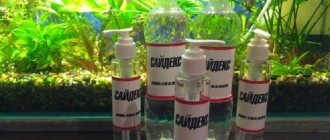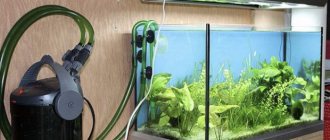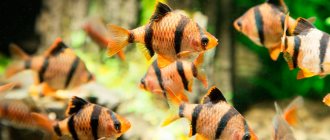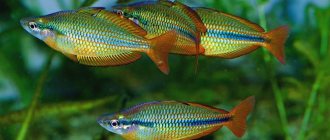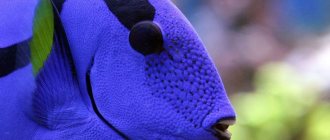The mysterious word “aquarium science” has resonated in the heart, but where to start, what to grab onto? What is needed for an aquarium, which aquarium is better to choose, what aquarium fish can pet stores offer for beginners?
It’s worth saying right away: almost all fish are suitable for beginners, they just need to create suitable conditions . Aquarium keeping is a lifelong pursuit; it requires a responsible approach. No issue is insignificant, all aspects of aquarium life are important.
An aquarium for beginners is like a complex crossword puzzle: some people become interested in fish all their lives, while others give up as soon as they start.
Choosing an aquarium
The arrangement begins with the purchase of a glass fish house. Aquariums are sold in different shapes and sizes. The most stable bacterial environment is formed in large tanks, so a spacious aquarium is suitable for dummies. The advantage of such a capacity is also the settlement of a larger number of fish and the ability to breed pets. Give preference to the classic rectangular shape. A spherical or unusually shaped vessel will become a source of stress for the fish.
Installation Requirements
To properly install an aquarium for beginners, an aquarist should adhere to the following rules:
- The tank is installed in a place where there is no direct sunlight, there is no constant noise and movement.
- The surface on which the item is placed must support the weight of the glass reservoir.
- All manipulations with the aquarium (raising the lid, washing the filter or changing the liquid) must be carried out without obstacles.
- Think in advance where the equipment is connected.
Water
Prepare the water before starting. It settles for at least a day; it should not contain chlorine or other harmful impurities. You will need special water tests and a bacterial culture for the first run. Some types of fish need soft or, conversely, hard water. The liquid is softened by boiling or freezing. Water becomes harder due to stones and shells.
Equipment
To keep fish comfortable in an aquarium, purchase the necessary equipment. Equipment providing main functions:
- Internal filter. Suitable for a small aquarium. Filters water, preventing cloudiness and stagnation. Before purchasing, read the instructions, which outline the characteristics of the device and operating rules.
- External filter. External devices are more expensive. Filter the liquid in larger tanks.
- Compressor for saturating water with oxygen. Provides a comfortable existence for the fish.
- Thermometer. Allows you to monitor the temperature.
- Temperature regulator. Heaters with pond coolers are especially useful on hot or cold days.
- Lamp. Plants need lighting more than fish. The light will ensure normal growth of aquarium flora and imitate the natural habitat.
Cleaning the glass
Photo from the site vdmir.vdmir.lclients.ru
Rotting and blooming algae leave a noticeable coating on the walls, which spoils the appearance of the aquatic dwelling. To remove it, you need a special tool:
- Scraper with a metal blade.
- Washcloth (new!).
- Magnetic scraper.
Scraper with a metal blade. It perfectly removes all kinds of contaminants, but is not suitable for aquariums made of organic glass, because it severely injures it due to its hardness. It is easy to find at any pet store. Ideal for removing thick layers of dirt.
Washcloth. The cheapest device for removing plaque. However, it is very inconvenient to wipe large aquariums with a washcloth and you will have to reach the farthest corners with your hand. It is also not suitable for plexiglass. And using an old washcloth can lead to dangerous infections and even death of the fish!
Magnetic scraper . One of the most popular glass cleaning tools. The action is based on two magnets: one with soft material attached, the other with hard bristles.
Among the advantages:
- Does not scratch glass (provided that sand does not get into it!).
- Can be found in any store.
- There is no need to wet your hands - the scraper is long enough.
- Ideal for cleaning plexiglass and very large and deep containers.
Disadvantages:
- Cheap scrapers may contain low-quality hard bristles, so cleaning may be difficult.
- The weak magnets in inexpensive versions of this scraper may not be able to handle the thick glass of some aquariums.
- This tool does not clean the corners of the aquarium well.
Please note that there is no need to catch cleaned algae particles. Almost all of them will go away with a water change, and the rest will serve as food for the fish.
Accessories
Sometimes the glass tank comes complete with cabinets and lids with built-in lighting. This option is useful if there is no space to install the vessel. The cabinet is designed to support the weight of a water container, and there are compartments for storing aquarium accessories. The lid is convenient because it prevents fish from jumping out and relieves the aquarist from the inconvenience associated with installing lighting.
Composition of aquarium soil
Particular attention should be paid to the selection of soil. Under no circumstances should you use sand from the banks of reservoirs for the bottom. It may contain protozoa that can cause fish diseases. Too shallow soil is also not suitable, since it is difficult to clean it from waste products of the inhabitants of the aquarium, as well as food residues and other contaminants.
The ideal option would be basalt soil. Not only is it easy to clean, which is a plus for beginners, but it also softens tap water. The soil should be poured in a layer of 4-8 cm, depending on the plants and the development of their root system.
Choosing fish
Start your journey in aquarium keeping with small, unpretentious aquarium fish. Beautiful, unpretentious fish suitable for the role of first aquarium pets:
- viviparous (guppies, platies, swordtails, mollies);
- catfish (Ancistrus, Corydoras);
- zebrafish;
- cardinal;
- lalius.
These fish live in different temperatures and water conditions, making them a must-have for a beginner.
Feeding
Grains of food for the inhabitants of the upper layers of water should not fall to the bottom. Special dry balanced food is sold for different types of fish. Diversify your diet with plant foods and frozen food.
Pets must eat all the food given to them within five minutes.
Treat food with boiling water; for small fish, serve chopped food. Large aquarium inhabitants are given large granules. Feed the fish at the same time, create a diet based on their needs.
Daily worries
The difficulties of daily care will mainly consist of feeding the fish. In addition, you need to make sure that all the fish are present, acting normally and healthy. It is necessary to check that all equipment - heating, filtration, aeration and lighting - is working well. Ideally, these checks should be done twice daily.
As a rule, there is no need to check parameters such as water chemistry and quality on a daily basis. This should only be done if, for example, you are changing the pH slowly, or if you know there is a problem and are monitoring it (by measuring pH fluctuations or ammonia and nitrite levels), or if you suspect there is a problem.
Fish inspection
The best time to inspect fish is during feeding time, when most fish come out of hiding to feed. If the fish are nocturnal, then they may need to be inspected using a flashlight. Secretive fish mostly have individual hiding places, and you should find out where they are. If any fish appears unhealthy or is behaving strangely, try to determine the cause and take appropriate action. If you are unable to determine the cause, keep the fish under close observation.
If any fish die, remove the carcass from the tank immediately and dispose of it safely.
Equipment check
Equipment checks can be done either while the fish are feeding or when you turn on or off the lights in the aquarium. The water temperature must be within the specified range, the water must be flowing through the filter, air must be flowing from the air pump, and the lights must be working.
If you use several heating devices, you need to check that they are all working. If one or two thermostats fail, the remaining one can maintain the required temperature in the aquarium for some time. It is better to quickly replace broken equipment and install new ones before the aquarium is left without heating at all. If the thermostat indicator light indicates the heater is on, convection currents should be visible in the water directly above the submerged heater. You can simply turn off the power and touch the heater (do this with caution - it can be very hot!) to see if it is warm. Heating mats that are placed under the aquarium and cable heaters that are buried in the substrate can only be tested by monitoring the temperature of the water in the aquarium.
If the filter performance is insufficient, the reason may be that the filter material is clogged (see below).
Plant selection
It is impossible to provide complete care for an aquarium without aquatic plants. They are important for those who want to get into aquascaping. It is better to choose unpretentious aquarium plants that can live at different temperatures, water parameters, and minimal lighting. Suitable for beginners:
- elodea;
- Vallisneria;
- Riccia floating;
- key, Java moss;
- pinnate;
- Thai ferns, pterygoid;
- Echinodorus Amazonis;
- hornwort.
How to properly care for an aquarium
Caring for an aquarium at home is easy - constantly monitor the internal state of the environment. Take your time when cleaning the tank or changing the water. The process requires patience and regularity, as well as some knowledge and experience.
Soil cleaning
The frequency of using the siphon depends on the volume of the aquarium and the conditions of detention. You need to siphon the soil paying attention to each section of the bottom.
During the cleaning process, water flows out along with impurities. The water pressure is regulated by the position of the container into which the dirty water flows. You can combine water changes with soil cleaning. Before siphoning, turn off the aquarium equipment. Remove decorations and wash them separately.
Cleaning the filter
All filter elements are washed with aquarium water. Rinsing under running water will destroy colonies of beneficial bacteria. It is recommended to change the filter material every six months.
Water change
Maintaining an aquarium at home involves partial water changes once a week. Under no circumstances should the water be completely replaced with fresh water. The amount of new water should not exceed 25%. Sudden changes in temperature and biochemical composition of water are harmful to fish. Changes are made with clean, settled water.
Newbie mistakes
The most common mistakes:
- Small aquarium . This is a common misconception. However, maintaining an ecosystem in a large (100 liter) aquarium is an order of magnitude easier than in a 30 liter one.
- Disabling the filter . The filter must function all the time, without weekends or holidays. It is this device that is responsible for water purification; its inaction can lead to an increase in the concentration of toxic substances.
- Overpopulation of an aquarium , when the volume of the tank is designed for fewer inhabitants than live in it.
- Too much feed . The fish will swim to the feeder every time a person appears to feed them. But this does not mean that they are hungry. You should not give food more than once a day.
Many new discoveries await the beginning aquarist. Be patient and success will certainly come. The main thing is to methodically follow the recommendations of more experienced underwater fauna lovers.


